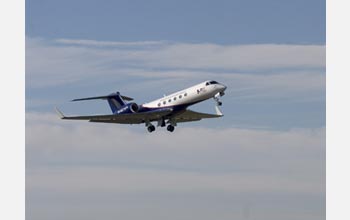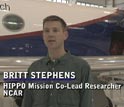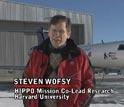|

Press Release 09-001
Scientists Take off on Historic Mission to Measure Greenhouse Gases That Have an Impact on Climate

January 7, 2009
View videos of Britt Stephens of NCAR and Steven Wofsy of Harvard University describing the HIAPER mission.
HIAPER, one of the nation's most advanced research aircraft, is scheduled to embark on an historic mission spanning the globe from the Arctic to the Antarctic. Starting Jan. 7, 2008, the HIAPER Pole-to-Pole Observations (HIPPO) mission will cover more than 24,000 miles as an international team of scientists makes a series of five flights over the next three years sampling the atmosphere in some of the most inaccessible regions of the world. The goal of the mission is ambitious--the first-ever, global, real-time sampling of carbon dioxide and other greenhouse gasses across a wide range of altitudes in the atmosphere, literally from pole-to-pole. To date, much of our understanding of global atmospheric greenhouse gasses has been acquired from distant satellites, balloon launches, or highly sophisticated supercomputer models. HIAPER's pole-to-pole mission will, for the first time, give scientists real-time global observation data to correlate with those climate models. HIAPER is short for the National Science Foundation's High-performance Instrumented Airborne Platfrom for Environmental Research. A modified Gulfstream V jet, it can fly at high altitudes for extended periods of time and can carry 5,600 pounds of sensing equipment, making it a premier aircraft for scientific discovery. HIPPO is a joint project being led by Harvard University. Other partners include the National Science Foundation, the National Center for Atmospheric Research, the National Oceanic and atmospheric Administration and the Scripps Institution of Oceanography.
-NSF-

Media Contacts
Dana Topousis, National Science Foundation (703) 292-7750 dtopousi@nsf.gov
Josh Chamot, National Science Foundation (703) 292-7730 jchamot@nsf.gov

The National Science Foundation (NSF) is an independent federal agency that
supports fundamental research and education across all fields of science and
engineering, with an annual budget of $6.06 billion. NSF funds reach all 50
states through grants to over 1,900 universities and institutions. Each year,
NSF receives about 45,000 competitive requests for funding, and makes over
11,500 new funding awards. NSF also awards over $400 million in
professional and service contracts yearly.
 Get News Updates by Email Get News Updates by Email
Useful NSF Web Sites:
NSF Home Page: http://www.nsf.gov
NSF News: http://www.nsf.gov/news/
For the News Media: http://www.nsf.gov/news/newsroom.jsp
Science and Engineering Statistics: http://www.nsf.gov/statistics/
Awards Searches: http://www.nsf.gov/awardsearch/
| 



